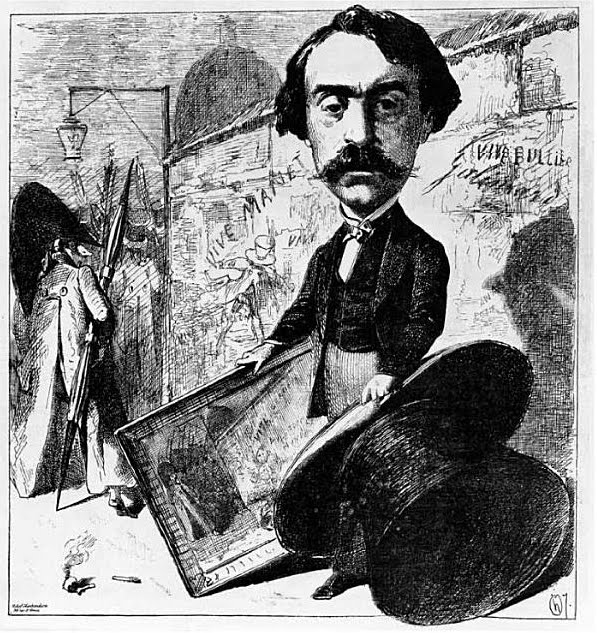The Execution of Marshal Ney on:
[Wikipedia]
[Google]
[Amazon]
''The Execution of Marshal Ney'' () is an 1868 painting by the French artist Jean-LÃĐon GÃĐrÃīme. It depicts the French Marshal Michel Ney immediately after his execution on 7 December 1815, with the

 The painting was presented at the 1868
The painting was presented at the 1868
firing squad
Execution by firing squad, in the past sometimes called fusillading (from the French ''fusil'', rifle), is a method of capital punishment, particularly common in the military and in times of war. Some reasons for its use are that firearms are us ...
seen marching away from the site. On the wall behind Ney's corpse are two inscriptions: one that says "vive l'empereur" ("long live the emperor") and is crossed out, and one that says "vive" right before the bullet holes from the execution. According to GÃĐrÃīme this was a comment on Ney's multiple shifts of allegiance between Napoleon
Napoleon Bonaparte ; it, Napoleone Bonaparte, ; co, Napulione Buonaparte. (born Napoleone Buonaparte; 15 August 1769 â 5 May 1821), later known by his regnal name Napoleon I, was a French military commander and political leader who ...
and the House of Bourbon
The House of Bourbon (, also ; ) is a European dynasty of French origin, a branch of the Capetian dynasty, the royal House of France. Bourbon kings first ruled France and Navarre in the 16th century. By the 18th century, members of the Spanis ...
..
The painting has been owned by the Sheffield Galleries and Museums Trust since 1931, and is now in the collection of the Graves Art Gallery
Graves Art Gallery is an art gallery in Sheffield, England. The gallery is located above the Central Library in Sheffield city centre. It houses permanent displays from the cityâs historic and contemporary collection of British and European ar ...
in Sheffield
Sheffield is a city status in the United Kingdom, city in South Yorkshire, England, whose name derives from the River Sheaf which runs through it. The city serves as the administrative centre of the City of Sheffield. It is Historic counties o ...
, England.
Historical background
Michel Ney was a marshal in Napoleonâs army, a heroic figure called "the bravest of the brave" byNapoleon
Napoleon Bonaparte ; it, Napoleone Bonaparte, ; co, Napulione Buonaparte. (born Napoleone Buonaparte; 15 August 1769 â 5 May 1821), later known by his regnal name Napoleon I, was a French military commander and political leader who ...
.Chandler 1999, p. 314. When Napoleon abdicated in 1814, Ney pledged his allegiance to the Bourbon monarchy, but when Napoleon returned to France, Ney rejoined his former leader. When the monarchy was restored in 1815, Marshal Ney was accused of plotting Napoleonâs return and charged with treason. At his execution he refused to wear a blindfold and was allowed to give the order to fire.
Reception

 The painting was presented at the 1868
The painting was presented at the 1868 Paris Salon
The Salon (french: Salon), or rarely Paris Salon (French: ''Salon de Paris'' ), beginning in 1667 was the official art exhibition of the AcadÃĐmie des Beaux-Arts in Paris. Between 1748 and 1890 it was arguably the greatest annual or biennial art ...
. Although Ney's execution was over fifty years in the past, a depiction of the incident still roused emotions and created controversy. On behalf of Ney's descendants, GÃĐrÃīme was asked to withdraw the painting, but he did not comply.
The general reception was very split and the 1868 Salon marked the beginning of a lasting divide between GÃĐrÃīme and many French art critics. Those who were negative accused the painting of relying on literary techniques, of commercializing art, and of bringing politics into art. ThÃĐophile Gautier wrote a positive review highlighting details that give the picture meaning, GÃĐrÃīme's treatment of the death theme, and the success of the painting at capturing a mental climate.
Henri Oulevay made a caricature where GÃĐrÃīme is depicted in front of the wall with art critics as the departing firing squad, carrying pens and quills instead of rifles. "Vive Manet" is scrawled on the wall, a reference to '' The Execution of Emperor Maximilian'' series of paintings made by Ãdouard Manet
Ãdouard Manet (, ; ; 23 January 1832 â 30 April 1883) was a French modernist painter. He was one of the first 19th-century artists to paint modern life, as well as a pivotal figure in the transition from Realism to Impressionism.
Born ...
that graphically depicted the execution by firing squad of Emperor Maximilian I of Mexico in 1867.
The previous year, GÃĐrÃīme had exhibited '' The Death of Caesar'', which has structural and thematic similarities to ''The Execution of Marshal Ney'', with the corpse in the foreground and the killers departing with their backs to the viewer. In that painting, too, (as also in ''The Duel After the Masquerade
''The Duel After the Masquerade'' is a painting by the French artist Jean-LÃĐon GÃĐrÃīme, of which multiple copies exist. The original, ''Suite d'un bal masquÃĐ'', first shown in 1857, is in the MusÃĐe CondÃĐ in Chantilly, France.
History
GÃĐr ...
'' and ''Jerusalem''), "characteristically, GÃĐrÃīmeâĶdepicted not the incident itself, but its immediate aftermath."
References
;Notes ;Literature * * {{DEFAULTSORT:Execution of Marshal Ney 1868 paintings Paintings by Jean-LÃĐon GÃĐrÃīme Paintings in the collection of Sheffield Museums Paintings about death Cultural depictions of French men Cultural depictions of military officers